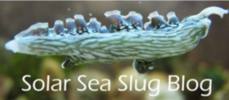

Journal Club: A Sea Slug’s Guide to Plastid Symbiosis
The Elysia literature is rich, varied, and growing constantly. From time to time, I will highlight a recent paper that strikes my fancy.
The paper of the moment is a recent review by de Vries and his colleagues that, from my point of view, demonstrates how the field of kleptoplasty in sacoglossans is maturing as a growing number of researchers apply diverse methods and approaches. Although I will summarize some of the highlights below, it is worth reading this short, nicely written paper for yourself (de Vries et al., 2014, Acta Soc Bot Pol 83: 415-421)
This paper illustrates a larger point that I have had to learn repeatedly during my career: as much as possible, one needs to look at the data and the biology, unfiltered by the way you think it should work. Almost invariably, one generates a mental model to organize one’s observations about a biological system. This model forms the basis for additional experiments, which can potentially support the model, but which almost always show you how naïve and simple your initial model was. The model is essential to focus one’s thinking, but any biological system is more complex (and therefore more interesting) than your limited human mind can imagine. So, there comes a time to listen to what the biology is telling you, and to think very hard about the next generation of models.
The paper by deVries and colleagues highlights that the field is at a point where researchers can, and must, think more deeply about the mechanisms and functions of kleptoplasty. They lay out a series of fundamental unanswered questions regarding the biology of solar sacoglossans.
- How do the slugs sort the kleptoplasts from the stuff that gets digested? When sacoglossans feed, they pierce the wall of an algal cell with a specialized radullar tooth, and suck out the contents. The extracted material contains mostly stuff the slugs will digest immediately (e.g., cytoplasm, nuclei, mitochondria), but also chloroplasts. How does a slug’s digestive system handle the material, with chloroplasts segregated and moved from digestive organelles to the cytoplasm, where photosynthesis can continue?
- How are stolen plastids maintained? Despite initial reports of horizontal transfer of genes from the genomes of the plants to those of the slugs, more recent experiments indicate that this is not the case. So how are the kleptoplasts maintained in a functional state without an algal genome (remember, the nucleus was digested) to direct the synthesis of the structural proteins and enzymes needed to replace those that are constantly degraded? Perhaps the kleptoplasts carry the capability with them, but the details remain mysterious.
- What is special about the biology of slug and algal species that participate in long-term retention (LTR) of chloroplasts for up to months at a time. There are seven species of sacoglossans known to be LTR slugs. These seven slugs are not monophyletic (i.e., are not derived from a common ancestor), and vary in the details of their diets. Some, like E. chlorotica, specialize on a single food plant, whereas others (e.g., E. clarki) feed on multiple species. In some cases, LTR species feed on the same food plants as short-term retention (STR) species, which maintain plastids for only a few days or weeks (e.g., E. clarki vs. E. papillosa). The slugs themselves, therefore must have some specializations to enable LTR. However, in a given LTR species, retention times vary for kleptoplasts of different algal species. These observations indicate that both the slugs and the algae have specializations, completely unknown at this point, that enable long-term survival of chloroplasts inside LTR slugs’ cells.
- Possibly the most fundamental question regards the functions of stolen chloroplasts: what good are kleptoplasts anyway? Multiple experiments have demonstrated that photosynthesis alone cannot support slug survival in the long term, and it is currently unclear whether starch produced by photosynthesizing kleptoplasts even enters the slugs’ cytoplasm. One hypothesis is that the plastids serve as “living larders,” being digested as needed by the slugs during periods of starvation. Kleptoplasts may also produce biochemicals needed by the slugs. For example it has been suggested that juveniles may depend on kleptoplast-derived lipids during their development. It is surprising that the function of long-term kleptoplasty remains mysterious so many years after its discovery.
- I wanted to end with an issue that the authors touched on briefly, that of photobehavior. Experiments have been performed examining phototaxis and parapodial extension in response to light, with the interpretation of the data being strongly influenced by the assumption that the behaviors support photosynthesis in some way. This issue is of particular interest to me, and, although a full discussion of the literature must await a future post, a lot of the data are not really consistent with the behaviors serving to optimize photosynthesis. Like, why aren’t slugs most active in mid-day, or why do they seem to be most affected by wavelengths in the middle part of the spectrum that are nearly useless for photosynthesis? From my point of view, some hard thinking about experimental design and interpretation are in order.
The paper ends with a quote from Ed Yong that echoes my introduction to this blog post, but is much more eloquent: “Science is about resisting the easy pull of conclusions. It’s about testing stories that seem like they should be right to see if they actually are right.”
As the study of kleptoplasty evolves from “gosh, wow, a photosynthetic slug” to a more complex and interesting view of the animals’ biology, the questions become more focused and more sophisticated. It will be fun to watch, and with a little time and effort, participate in the process.

Recent Comments